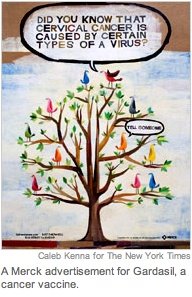Drug makers’ push leads to cancer vaccines’ rise

New York, NY
In two years, cervical cancer has gone from obscure killer confined mostly to poor nations to the West’s disease of the moment.
“Merck lobbied every opinion leader, women’s group, medical society, politicians, and went directly to the people — it created a sense of panic that says you have to have this vaccine now.”
Dr. Diane Harper, a professor of medicine at Dartmouth Medical School
Tens of millions of girls and young women have been vaccinated against the disease in the United States and Europe in the two years since two vaccines were given government approval in many countries and, often, recommended for universal use among females ages 11 to 26.
One of the vaccines, Gardasil, from Merck, is made available to the poorest girls in the country, up to age 18, at a potential cost to the United States government of more than $1 billion; proposals to mandate the vaccine for girls in middle schools have been offered in 24 states, and one will take effect in Virginia this fall. Even the normally stingy British National Health Service will start giving the other vaccine — Cervarix, from GlaxoSmithKline — to all 12-year-old girls at school this September.
The lightning-fast transition from newly minted vaccine to must-have injection in the United States and Europe represents a triumph of what the manufacturers call education and their critics call marketing. The vaccines, which offer some protection against infection from sexually transmitted viruses, are far more expensive than earlier vaccines against other diseases — Gardasil’s list price is $360 for the three-dose series, and the total cost is typically $400 to nearly $1,000 with markup and office visits (and often only partially covered by health insurance).
Award-winning advertising has promoted the vaccines. Before the film “Sex and the City,” some moviegoers in the United States saw ads for Gardasil. On YouTube and in advertisements on popular shows like “Law and Order,” a multiethnic cast of young professionals urges girls to become “one less statistic” by getting vaccinated.
The vaccine makers have also brought attention to cervical cancer by providing money for activities by patients’ and women’s groups, doctors and medical experts, lobbyists and political organizations interested in the disease, sometimes in ways that skirt disclosure requirements or obscure the companies’ involvement.
Even critics of the marketing efforts recognize the benefits of the vaccines. Girls who get the shots are less likely to have Pap tests with worrisome results that would lead to further treatment, saving themselves anxiety and discomfort and, in those cases, saving money. When it occurs, cervical cancer is a dreadful disease; genital warts, partly prevented by the Merck vaccine, can be a painful nuisance.
But some experts worry about the consequences of the rapid rollout of the new vaccines without more medical evidence about how best to deploy them. They say that because of the aggressive marketing, even parents of girls who are far from being sexually active may feel pressured into giving them a vaccine that is not yet needed and whose long-term impact is still unclear. Legislative efforts to require girls to have the vaccine only add to the pressure.
In the United States, hundreds of doctors have been recruited and trained to give talks about Gardasil — $4,500 for a lecture — and some have made hundreds of thousands of dollars. Politicians have been lobbied and invited to receptions urging them to legislate against a global killer. And former state officials have been recruited to lobby their former colleagues.
“There was incredible pressure from industry and politics,” said Dr. Jon Abramson, a professor of pediatrics at Wake Forest University who was chairman of the committee of the Centers for Disease Control and Prevention that recommended the vaccine for all girls once they reached 11 or 12.
“This big push is making people crazy — thinking they’re bad moms if they don’t get their kids vaccinated,” said Dr. Abby Lippman, a professor at McGill University in Montreal and policy director of the Canadian Women’s Health Network. Canada will spend $300 million on a cervical cancer vaccine program.
Merck’s vaccine was studied in clinical trials for five years, and Glaxo’s for nearly six and a half, so it is not clear how long the protection will last. Some data from the clinical trials indicate immune molecules may wane after three to five years. If a 12-year-old is vaccinated, will she still be protected in college, when her risk of infection is higher? Or will a booster vaccine be necessary? Read more, "Drug makers’ push leads to cancer vaccines’ rise."
Labels: Cervical Cancer Prevention, Gardasil, HPV Vaccine

0 Comments:
Post a Comment
<< Home